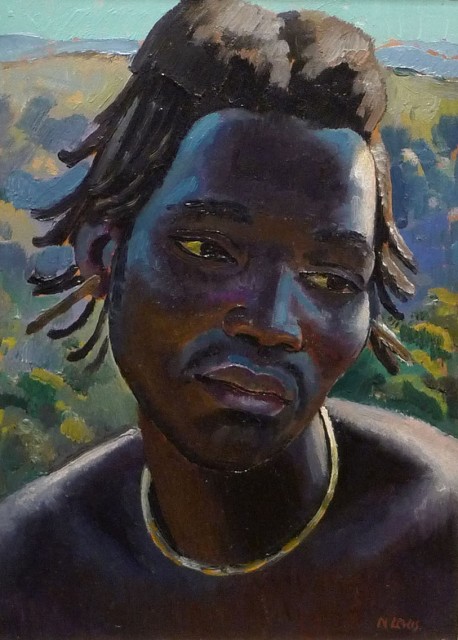Alfred Neville Lewis
(1895 – 1972)
‘He has seen a good deal of the world, hobnobbed with kings and prices, enjoyed the friendship of prime minsters and the hospitality of his commanding officers during WW2. He has also recorded the features of tribal Bantu in remote South African kraals and has been accepted by the insouciant inhabitants of Gypsy caravans in the countryside of England’
Esmé Berman ‘Art and Artists of South Africa’ 1970
Alfred Neville Lewis was a South African artist, who was born and educated in Cape Town, but in 1912 moved in England to concentrate on his artistic studies. He was first taught by Stanhope Forbes in the artistic colony of Newlyn, Cornwall and later formally trained at the Slade School of Art in London. Here Neville Lewis was a pupil Henry Tonks, Ambrose McEvoy and most importantly Augustus John, who encouraged him to develop his own style of portraiture.
Whilst serving during World War I in France, Belgium and Italy, Neville Lewis continued to paint portraits in oil, taking on a studio in London after the war and concentrating on portrait painting, for which he acquired a reputation. He revisited South Africa a number of times, often painting tribal subjects and portraits of black South African’s, which became popular addition to his London exhibitions. When the Second World War broke out, Neville Lewis was commissioned as his native country’s first official War Artist, recording the portraits of both great and lesser known personnel in Kenya and North Africa. He also designed the South African postage stamps during this time. After returning for a brief period in the forties to England, he finally left and settled permanently in Stellenbosch and accepted portrait commissions in all parts of South Africa.
Neville Lewis was attracted from early in his career to the paintings of Augustus John and certainly the colour, composition and mannerisms in his portraits often allude to his teacher’s work. The most notable influence however must be Neville Lewis’s break with the traditional photographic treatment of representation and his relatively informal rendering of his sitters marks his portraits out from other South African portrait paintings.
As a portrait painter, Neville Lewis undertook a number of important commissions, including Sir Winston Churchill, King Alfonso XIII of Spain, King George II of Greece, Field-Marshall Lord Montgomery, Chief Tshekedi Khama and Paul Sauer.
During his lifetime Neville Lewis held numerous one-man exhibitions in London, South Africa, Europe and the USA. He was included in the South African War Art at the Royal Academy (1948) and Oversees exhibition of South African Art at the Tate (1952), as well as in several leading exhibitions in South Africa. His work is now held in the SA National Gallery, Cape Town, Johannesburg Gallery, Durban Art Gallery and in Britain, the National Gallery, Tate, Imperial War Museum and also various European galleries, such as the Gallery of Modern Art in Madrid.
